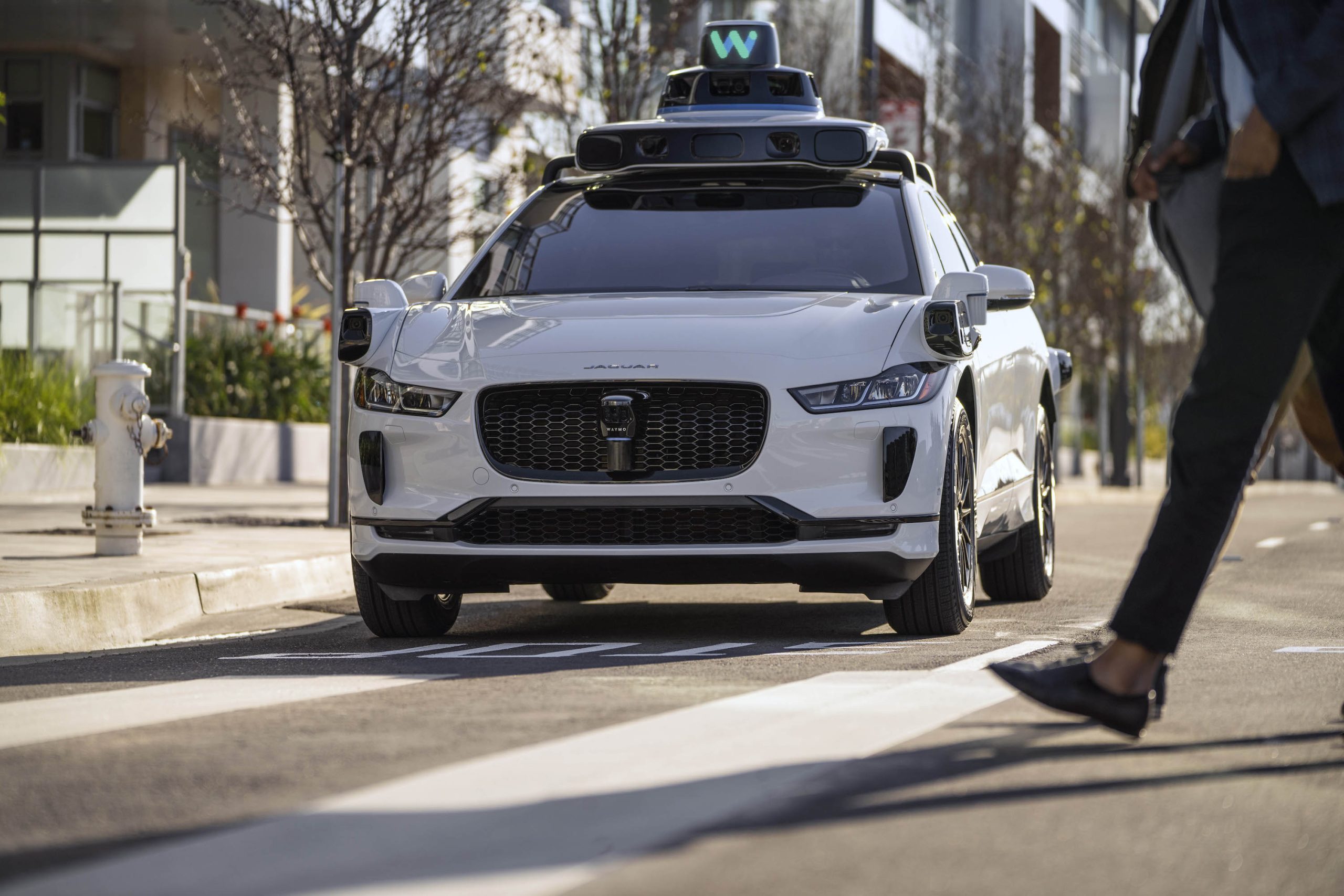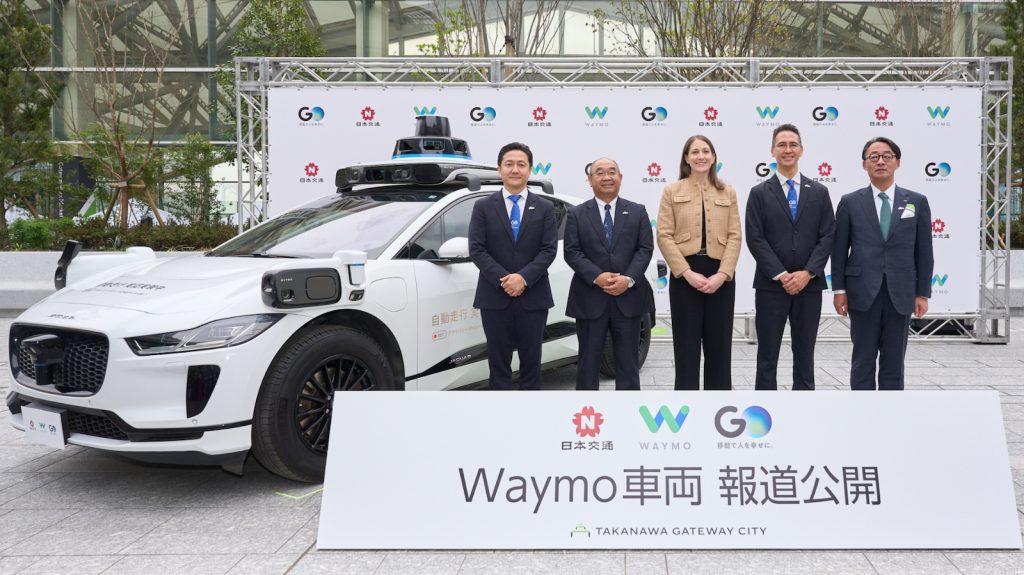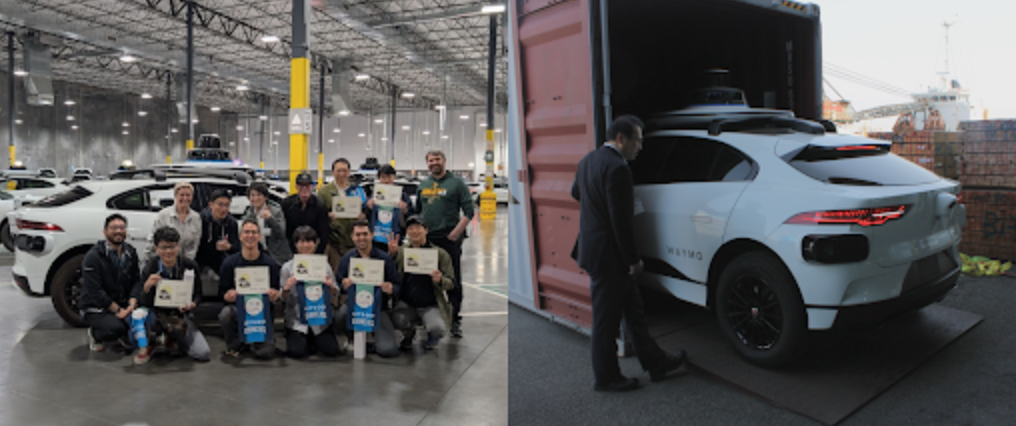News
Waymo kicks off initial tests in Japan with launch event
Waymo launches early tests in Japan, as Tesla and others look to roll out their own commercial robotaxi services.

Commercial robotaxi company Waymo held a launch event in Japan last week, as the company prepares to enter early manual testing on its first international roads.
After Waymo shared plans to start testing vehicles in Japan in December, the Google-owned firm detailed the launch event in a press release on Monday. The event featured officials from project partners GO, a taxi platform, and Nihon Kotsu, the largest taxi company in Tokyo, along with featuring one of the company’s camera-, lidar-, and radar-outfitted Jaguar I-Pace units, expected to begin manual testing around Tokyo in the weeks to come.
Ichiro Kawanabe, Board Director at Nihon Kotsu and Chairman at both GO and the Japan Taxi Association, said that Waymo’s U.S. operations “demonstrated significant safety benefits,” along with thanking the company for hosting the event at the newly developed Takanawa Gateway City complex.
“I took my first ride with Waymo in Phoenix a year and a half ago and was amazed that there was really no one in the driver’s seat,” the chairman said. “That was the moment I was convinced that autonomous driving technology could absolutely benefit Japan. It will help ensure mobility service in the future of Japan, with the growing aging population and labor shortage.”

Credit: Waymo

Credit: Waymo
This spring, Nihon Kotsu taxi operators will start driving Waymo vehicles across several Tokyo wards this spring, including Chiyoda, Chūō, Kōtō, Minato, Shibuya, Shinagawa, and Shinjuku. The tests will utilize 3D maps of the city, along with utilizing experienced drivers to generate data about traffic laws, patterns, and other road systems ahead of fully autonomous operation.
“After months of strong collaboration with Nihon Kotsu and GO, Waymo has reached a historic milestone— our first venture on international public roads,” said Nicole Gavel, Waymo Senior Director and Head of Business Development and Strategic Partnerships.
“Our partnership demonstrates how Waymo’s 15 years of operational expertise can adapt to new environments through strategic initiatives with industry leaders,” Gavel adds. “In Tokyo, we are abiding by the same steadfast principles that guide us in the U.S. — commitment to safety, dedication to earning trust in communities where we operate, and collaboration with local officials and community groups here in Tokyo.”
The news comes as Tesla, Amazon-owned firm Zoox, and still others are racing to enter the commercial robotaxi business throughout this year. It also comes amidst widespread speculation and debate about the emerging market, and as Tesla and Waymo both aim to begin operations internationally.
READ MORE ON WAYMO: Waymo study analyzes collisions with vulnerable road users
Tesla’s FSD in China, Mexico, commercial robotaxis still incoming
Waymo is already operating paid autonomous ride-hailing services around the U.S., and it said in December that it was giving more than 200,000 autonomous rides per week.
The company currently offers Waymo services in San Francisco and Los Angeles, California, Phoenix, Arizona, and, through a partnership with Uber, in Austin, Texas, where Tesla has a Gigafactory and plans to launch initial robotaxi services. The Alphabet-owned company is also aiming to launch services in Atlanta, Georgia and Miami, Florida this year, alongside its early tests in Tokyo.
Although Tesla doesn’t currently operate driverless ride-hailing in any capacity, individual owners in North America can purchase or subscribe to its Supervised Full Self-Driving (FSD) system, on which the company’s forthcoming robotaxi platform will be based. In October, the company unveiled the two-seat Cybercab vehicle, which has no steering wheel or pedals and will be used for the upcoming commercial robotaxi system.
Additionally, the company is aiming to launch its first unsupervised rides commercially in Austin in June, and it recently debuted Supervised FSD in China and Mexico, marking the company’s first international markets.
🎥: Our FULL first ride in the @Tesla Cybercab pic.twitter.com/6gR7OgKRCz
— TESLARATI (@Teslarati) October 11, 2024
Waymo vs. Tesla vs. the competition
While Tesla hasn’t quite gotten a commercial robotaxi service to market yet, Waymo, Amazon-owned company Zoox, and still many others have begun their own paid ride-hailing services or early tests. Meanwhile, Tesla’s approach to the technology is vastly different than that of Waymo and others, utilizing a camera-only, AI-trained neural network system, rather than 3D geomapping.
For one, the company can generate a larger pool of training data from real-time driving behavior of its individual owners, for instance as compared to Waymo’s use of a more-limited fleet of taxi drivers. Many argue that this, along with the cost-effectiveness of producing a system that’s built into every vehicle and utilizes only cameras, make the system more scalable than those of Waymo and others.
Still, some support the use of more than just camera systems and building in sensor redundancy as a way to maximize safety, especially as the technologies are still fairly new. Former Waymo CEO John Krafcik, who was a part of the company until 2021, criticized the FSD system in December for not including enough safety measures to support a realistic commercial robotaxi business, and he went on to call Tesla “a car company with a driver-assist system.”
“If a company were serious about building a safe and accessible robotaxi business, it would look nothing like what was shown,” Krafcik said during an interview. “The cost of a robust sensor set, including lidar, is trivial on a per-mile basis. Even more so for mapping. And the safety benefits measured in human harm reduction are real and verifiable.”
Waymo valued at over $45 billion following latest financing round: report
Elon Musk
Tesla Supercharger Diner food menu gets a sneak peek as construction closes out
What are you ordering at the Tesla Diner?

The Tesla Supercharger Diner in Los Angeles is nearing completion as construction appears to be winding down significantly. However, the more minor details, such as what the company will serve at its 50s-style diner for food, are starting to be revealed.
Tesla’s Supercharger Diner is set to open soon, seven years after CEO Elon Musk first drafted the idea in a post on X in 2018. Musk has largely come through on most of what he envisioned for the project: the diner, the massive movie screens, and the intended vibe are all present, thanks to the aerial and ground footage shared on social media.
We already know the Diner will be open 24/7, based on decals placed on the front door of the restaurant that were shared earlier this week. We assume that Tesla Optimus will come into play for these long and uninterrupted hours.
The Tesla Diner is basically finished—here’s what it looks like
As far as the food, Tesla does have an email also printed on the front door of the Diner, but we did not receive any response back (yet) about what cuisine it will be offering. We figured it would be nothing fancy and it would be typical diner staples: burgers, fries, wings, milkshakes, etc.
According to pictures taken by @Tesla_lighting_, which were shared by Not a Tesla App, the food will be just that: quick and affordable meals that diners do well. It’s nothing crazy, just typical staples you’d find at any diner, just with a Tesla twist:
Tesla Diner food:
• Burgers
• Fries
• Chicken Wings
• Hot Dogs
• Hand-spun milkshakes
• And more https://t.co/kzFf20YZQq pic.twitter.com/aRv02TzouY— Sawyer Merritt (@SawyerMerritt) July 17, 2025
As the food menu is finalized, we will be sure to share any details Tesla provides, including a full list of what will be served and its prices.
Additionally, the entire property appears to be nearing its final construction stages, and it seems it may even be nearing completion. The movie screens are already up and showing videos of things like SpaceX launches.
There are many cars already using the Superchargers at the restaurant, and employees inside the facility look to be putting the finishing touches on the interior.
🚨 Boots on the ground at the Tesla Diner:
— TESLARATI (@Teslarati) July 17, 2025
It’s almost reminiscent of a Tesla version of a Buc-ee’s, a southern staple convenience store that offers much more than a traditional gas station. Of course, Tesla’s version is futuristic and more catered to the company’s image, but the idea is the same.
It’s a one-stop shop for anything you’d need to recharge as a Tesla owner. Los Angeles building permits have not yet revealed the date for the restaurant’s initial operation, but Tesla may have its eye on a target date that will likely be announced during next week’s Earnings Call.
News
Tesla’s longer Model Y did not scale back requests for this vehicle type from fans
Tesla fans are happy with the new Model Y, but they’re still vocal about the need for something else.

Tesla launched a slightly longer version of the Model Y all-electric crossover in China, and with it being extremely likely that the vehicle will make its way to other markets, including the United States, fans are still looking for something more.
The new Model Y L in China boasts a slightly larger wheelbase than its original version, giving slightly more interior room with a sixth seat, thanks to a third row.
Tesla exec hints at useful and potentially killer Model Y L feature
Tesla has said throughout the past year that it would focus on developing its affordable, compact models, which were set to begin production in the first half of the year. The company has not indicated whether it met that timeline or not, but many are hoping to see unveilings of those designs potentially during the Q3 earnings call.
However, the modifications to the Model Y, which have not yet been officially announced for any markets outside of China, still don’t seem to be what owners and fans are looking forward to. Instead, they are hoping for something larger.
A few months ago, I reported on the overall consensus within the Tesla community that the company needs a full-size SUV, minivan, or even a cargo van that would be ideal for camping or business use.
Tesla is missing one type of vehicle in its lineup and fans want it fast
That mentality still seems very present amongst fans and owners, who state that a full-size SUV with enough seating for a larger family, more capability in terms of cargo space for camping or business operation, and something to compete with gas cars like the Chevrolet Tahoe, Ford Expedition, or electric ones like the Volkswagen ID.BUZZ.
We asked the question on X, and Tesla fans were nearly unanimously in support of a larger SUV or minivan-type vehicle for the company’s lineup:
🚨 More and more people are *still* saying that, despite this new, longer Model Y, Tesla still needs a true three-row SUV
Do you agree? https://t.co/QmbRDcCE08 pic.twitter.com/p6m5zB4sDZ
— TESLARATI (@Teslarati) July 16, 2025
Here’s what some of the respondents said:
100% agree, we need a larger vehicle.
Our model Y is quickly getting too small for our family of 5 as the kids grow. A slightly longer Y with an extra seat is nice but it’s not enough if you’re looking to take it on road trips/vacations/ kids sports gear etc.
Unfortunately we…
— Anthony Hunter (@_LiarsDice_) July 17, 2025
Had to buy a Kia Carnival Hybrid because Tesla doesn’t have a true 3 row vehicle with proper space and respectable range. pic.twitter.com/pzwFyHU8Gi
— Neil, like the astronaut (@Neileeyo) July 17, 2025
Agreed! I’m not sure who created this but I liked it enough to save it. pic.twitter.com/Sof5nMehjS
— 🦉Wise Words of Wisdom – Inspirational Quotes (IQ) (@WiseWordsIQ) July 16, 2025
Tesla is certainly aware that many of its owners would like the company to develop something larger that competes with the large SUVs on the market.
However, it has not stated that anything like that is in the current plans for future vehicles, as it has made a concerted effort to develop Robotaxi alongside the affordable, compact models that it claims are in development.
It has already unveiled the Robovan, a people-mover that can seat up to 20 passengers in a lounge-like interior.
The Robovan will be completely driverless, so it’s unlikely we will see it before the release of a fully autonomous Full Self-Driving suite from Tesla.
Energy
Tesla launches first Virtual Power Plant in UK – get paid to use solar
Tesla has launched its first-ever Virtual Power Plant program in the United Kingdom.

Tesla has launched its first-ever Virtual Power Plant program in the United Kingdom. This feature enables users of solar panels and energy storage systems to sell their excess energy back to the grid.
Tesla is utilizing Octopus Energy, a British renewable energy company that operates in multiple markets, including the UK, France, Germany, Italy, Spain, Australia, Japan, New Zealand, and the United States, as the provider for the VPP launch in the region.
The company states that those who enroll in the program can earn up to £300 per month.
Tesla has operated several VPP programs worldwide, most notably in California, Texas, Connecticut, and the U.S. territory of Puerto Rico. This is not the first time Tesla has operated a VPP outside the United States, as there are programs in Australia, Japan, and New Zealand.
This is its first in the UK:
Our first VPP in the UK
You can get paid to share your energy – store excess energy in your Powerwall & sell it back to the grid
You’re making £££ and the community is powered by clean energy
Win-win pic.twitter.com/evhMtJpgy1
— Tesla UK (@tesla_uk) July 17, 2025
Tesla is not the only company that is working with Octopus Energy in the UK for the VPP, as it joins SolarEdge, GivEnergy, and Enphase as other companies that utilize the Octopus platform for their project operations.
It has been six years since Tesla launched its first VPP, as it started its first in Australia back in 2019. In 2024, Tesla paid out over $10 million to those participating in the program.
Participating in the VPP program that Tesla offers not only provides enrolled individuals with the opportunity to earn money, but it also contributes to grid stabilization by supporting local energy grids.
-

 Elon Musk1 day ago
Elon Musk1 day agoWaymo responds to Tesla’s Robotaxi expansion in Austin with bold statement
-

 News1 day ago
News1 day agoTesla exec hints at useful and potentially killer Model Y L feature
-

 Elon Musk2 days ago
Elon Musk2 days agoElon Musk reveals SpaceX’s target for Starship’s 10th launch
-

 Elon Musk3 days ago
Elon Musk3 days agoTesla ups Robotaxi fare price to another comical figure with service area expansion
-

 News1 day ago
News1 day agoTesla’s longer Model Y did not scale back requests for this vehicle type from fans
-

 News1 day ago
News1 day ago“Worthy of respect:” Six-seat Model Y L acknowledged by Tesla China’s biggest rivals
-

 News2 days ago
News2 days agoFirst glimpse of Tesla Model Y with six seats and extended wheelbase
-

 Elon Musk2 days ago
Elon Musk2 days agoElon Musk confirms Tesla is already rolling out a new feature for in-car Grok








